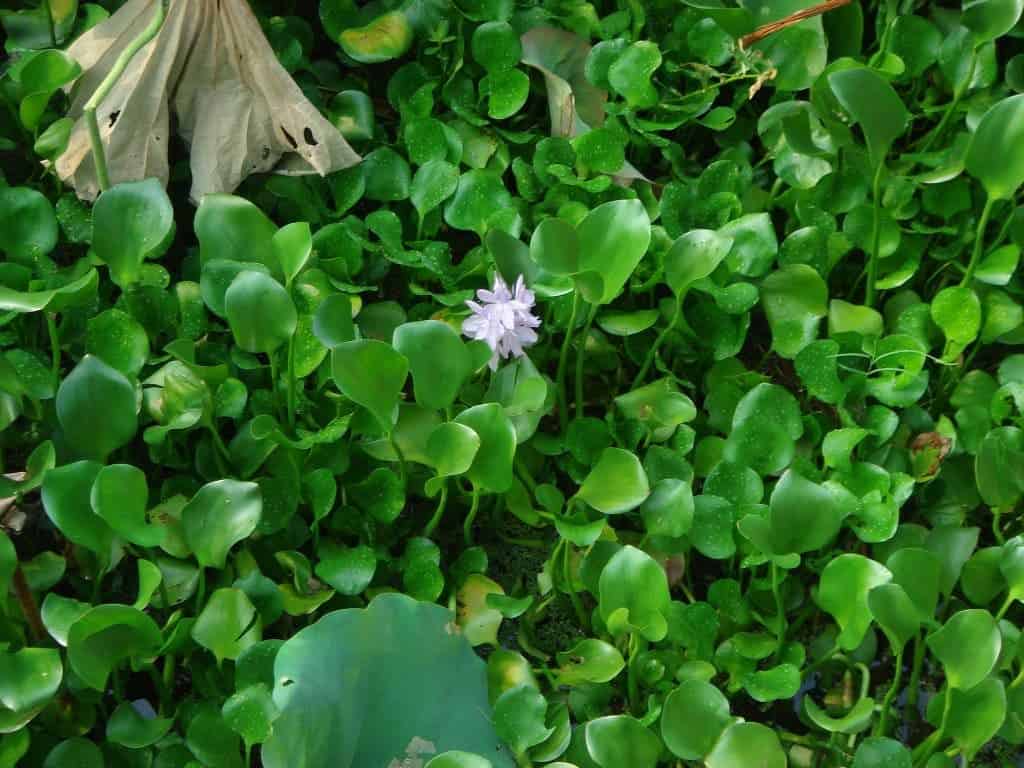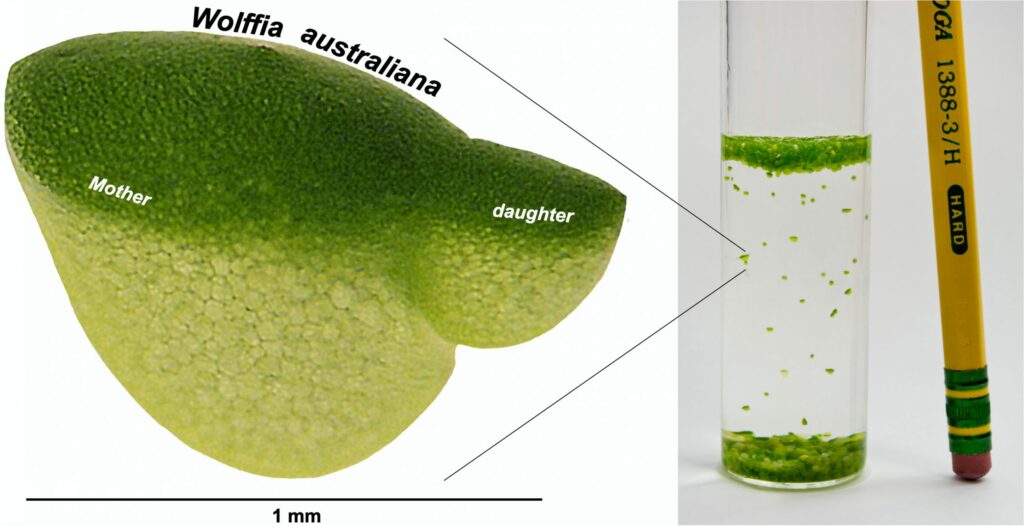Waterway caretakers have complained about it for decades. Most people barely even noticed it. But no one seemed to know why duckweed, considered the world’s fastest-growing plant, spreads so rapidly in many lakes and ponds. Now, a group of researchers seems to have found the answer, claiming it’s all about the plant’s capability to grow quickly in the dark.

Plants can grow pretty fast. Many trees at the equator reach maturity in as little as ten to twenty years, growing, from seedlings to impressive heights within 10 years.
Traditional wisdom would have bamboo as the fastest-growing plant. Indeed, bamboo can grow stunningly fast, sometimes becoming visibly bigger within a day. But other plants grow even faster, and the fastest growing trees have nothing on this little one. It doesn’t look like much, but according to some new research, it’s the fastest-growing plant in the world.
The fastest-growing plant
It’s easy to overlook duckweed, a tiny aquatic plant that floats on the surface of still waters. At first glance, you might even dismiss it as mere flotsam — but dig a bit deeper and you’ll find an ecological powerhouse. This unassuming plant can grow incredibly fast, and it has enormous potential for addressing some of the world’s biggest environmental and food security challenges.
Duckweeds can double their mass in between 16 hours to 2 days if they have optimal nutrient availability, sunlight, and water temperature. Even when things are not ideal, duckweed can grow very fast if it has what it needs. This is why the plant has become a bane of many lake caretakers who try to keep the ponds as neat as possible.
Duckweed’s magic lies in its simplicity. With a typical plant composed of a mere couple of leaves and a root hair, duckweed’s minimalist design fuels its impressive reproductive prowess. Speed is the game, and duckweed plays it well, reproducing not by seeds, but by budding. Researchers have known for some time that the plant can grow fast under indeal conditions, but this study has blown things out of the water.

A fast-growing “weed”
The duckweed family includes 37 species and can be found pretty much all over the world. Also known as Wolffia, the plants float on water, are easy to harvest, and can even grow on wastewater. They range from less than a millimeter to only a few millimeters in size and lack roots, containing only the green stuff you see floating frond.
Some strains of the plant have very high protein levels. This is why researchers have described them as more nutritious than a salad. Yes, you can eat duckweed and it’s also used as animal fodder or in other processed foods.
As its name implies, duckweed is eaten by ducks, as well as other animals, and even humans — but it acts very much like a weed. It grows very fast, especially in water-rich with nutrients such as nitrogen and phosphate.
“A lot of advancement in science has been made thanks to organisms that are really simple, like yeast, bacteria and worms,” Todd Michael, first author of the paper looking at duckweed, said in a statement. “The idea here is that we can use an absolutely minimal plant-like Wolffia to understand the fundamental workings of what makes a plant a plant.”
Working with a group of researchers from the Salk Institute in California, Michael focused on the characteristics in Wolffia’s genome that could explain its fast growth. The team grew the plants under light/dark cycles to establish which genes were active at different times of the day. The results were surprising.
Light and magic
Most plants are light-sensitive, which means they grow especially in the morning in response to sunshine. At night, they grow differently or slower. But this wasn’t the case of Wolffia. The researchers found the plant has half the number of genes that are regulated by light/dark cycles compared to other plants — so it can grow more at night. “It doesn’t have the regulations that limit when it can grow,” said Michael.
But that’s not its only distinctive feature. The researchers found that the genes usually linked with elements of behavior in plants such as defense mechanisms and root growth aren’t present in duckweed. For Michael, this means the plant has shed the genes it doesn’t need, evolving to focus on uncontrolled and fast growth.
Data about the Wolffia genome can provide important insight into the interplay between how plants develop their body plan and how they grow,” Joseph Ecker, a coauthor of the paper, said in a statement. “This plant holds promise for becoming a new lab model for studying the central characteristics of plant behavior, including how genes contribute to different biological activities.”
The findings will help scientists to understand how plants make trade-offs between growth and other functions, such as putting down roots and defending themselves from pests, the researchers argued. The findings could help to design new plants that are optimized for specific functions, such as increased carbon storage to help address climate change.
Previous studies have looked at duckweed but focused on something different rather than its fast growth. Researchers from Israel argued that mankai, a high-protein form of duckweed, could be the next superfood because it controls blood sugar levels after people eat carbohydrates, according to their findings.
How duckweed can be useful
Obviously, plants that grow fast can be useful. While fast-growing trees can be useful for reforestation projects and agricultural plants can be used, it’s less clear how duckweed can be useful. However, as mentioned, duckweed is also perfectly edible by humans. Not only that, but it can also serve as a high-value source of proteins, and also features several important minerals, vitamins, and antioxidants.
One of the other promising uses for duckweed is as a biofuel feedstock. Duckweed is a rich source of protein, starch, and oil, all of which can be converted into biofuels such as ethanol and biodiesel. Unlike other biofuel crops like corn and soybeans, duckweed can be grown on marginal land and does not compete with other crops, and neither does not require the use of fertilizers or pesticides, making it a more sustainable and eco-friendly alternative.
In addition, duckweed can also be used as animal feed, as it seems to be not only nutritious, but palatable as well, for a number of animals.
However, thorough research in duckweed is still relatively new. As promising as the plant appears to be, scaling production and finding ways to incorporate it sustainably won’t be easy. Still, this goes to show that there’s a lot of biological potential to tap into. We just have to make sure to do it in a way that solves problems rather than causes more problems.
Other fast-growing plants
Duckweed’s ability to grow so fast is absolutely striking, and as mentioned, the plant has a lot of potential in many fields. But it’s also limited by the fact that it only grows on bodies of water. If you’re interested in other plants that grow fast, here are a few.
| Plant Name | Fascinating Fact |
|---|---|
| Bamboo | Certain species of bamboo can grow up to 3 feet within a 24-hour period. Not only is this remarkable, bamboo also plays a crucial role in carbon sequestration, making it a front-runner in the fight against climate change. |
| Kudzu | This vine, native to Eastern Asia, can grow up to a foot per day. Known as the “vine that ate the South,” it was introduced in the US as a soil stabilizer but quickly became an invasive species due to its rapid growth and lack of natural predators. |
| Water Hyacinth | While a nuisance due to its invasive tendencies, water hyacinth can double its population in just two weeks. Despite this, it has been used for wastewater treatment because of its ability to absorb pollutants. |
| Duckweed | Though tiny, duckweed can double its population in a couple of days under optimal conditions. It’s seen as a promising prospect for sustainable agriculture due to its high protein content and capability to act as a water filter. |
| Giant Reed | Giant Reed is known to grow up to one foot per day. Interestingly, this plant is being researched as a potential source of biofuel because of its high biomass production. |
| Paulownia Tree | Often known as the ‘princess tree,’ Paulownia can grow up to 20 feet in its first year. Its wood is light yet strong, and it is used in the production of musical instruments, furniture, and surfboards. |
| Japanese Knotweed | Despite its beautiful appearance, Japanese Knotweed is a nightmare for homeowners. It can grow 3 feet in a month and is capable of breaking through concrete, causing significant structural damage. |
| Hydrilla | A freshwater plant, Hydrilla can grow up to an inch per day. Despite being an invasive species in many areas, it provides valuable habitats for fish and invertebrates. |
| Willow Tree | Willow trees can grow up to 10 feet per year, making them one of the fastest growing shade trees. They have a strong affinity for water, and their roots can help stabilize eroding lands. |
The study was published in the journal Genome Research.


